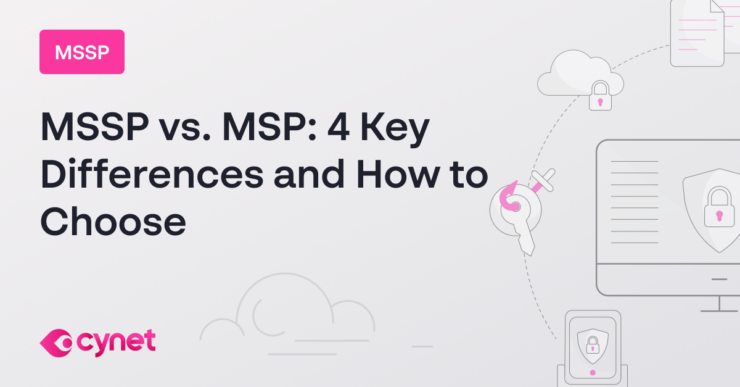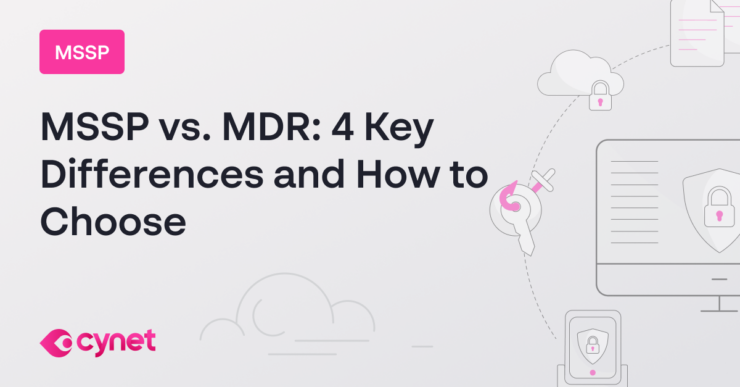July 22, 2024
Last Updated:
November 27, 2024
What Is an MSSP?
A Managed Security Service Provider (MSSP) provides outsourced monitoring and management of security devices and systems. Common services include managed firewall, intrusion detection, virtual private network, vulnerability scanning and antivirus services.
MSSPs typically provide 24/7 service, with staff available around the clock and highly-available infrastructure (either hosted in their own facilities or by other data center providers). This reduces the number of operational security personnel an enterprise needs to hire, train and retain to maintain a strong security posture.
MSSPs offer a systematic approach to managing an organization’s security needs. The services they provide are aimed at protection and management from various threats by continuous scanning and incident response. This ensures consistent protection from emerging threats, paired with expert management of security technologies and regular updates.
What Is Managed SIEM?
Security Information and Event Management (SIEM) is a technology that aggregates, monitors, analyzes, and reports on security data and events. Managed SIEM solutions collect and analyze log data generated across an organization’s IT infrastructure, from host systems and applications to network and security devices such as firewalls and antivirus filters.
Managed SIEM solutions are managed by a service provider, meaning the organization does not need to deploy and maintain their infrastructure. However, in-house security teams are typically responsible for operating the SIEM and using it to investigate and respond to security incidents.
The goal of managed SIEM is to provide real-time analysis of security alerts generated by applications and network hardware. SIEM tools aid in incident detection by correlating disparate data and providing security analysts with actionable insights. These insights help in quickly identifying, diagnosing, and responding to potential security incidents and threats.
This is part of a series of articles about MSSP security
How Are SIEM and MSSPs Related?
SIEM technology is often managed by MSSPs on behalf of their clients. This arrangement allows organizations to leverage advanced security analytics without investing heavily in internal resources. MSSPs integrate SIEM solutions into their broader service offerings, which include monitoring, management, and incident response.
When SIEM is built into an MSSP’s offering, this can offer better security outcomes than managed SIEM alone. MSSPs bring their expertise in managing and operating SIEM tools across diverse environments. Clients benefit from reduced complexity and improved security efficiency, enhancing their ability to detect and rapidly respond to threats.
MSSP vs. Managed SIEM: What Are the Differences?
1. Functions
MSSPs provide a range of security services including management, monitoring, and response functions critical for safeguarding an organization’s IT environment. Their services cover several layers of security management, from firewall management to incident response and remediation strategies, providing comprehensive coverage across multiple domains.
SIEM focuses mainly on the aggregation, analysis, and reporting of security event data. This function is crucial for real-time security alerting and forensic analysis, helping organizations identify and mitigate security threats based on the data collected from their IT landscape.
2. Scope
MSSPs operate with a broad scope, offering end-to-end security solutions that address multiple aspects of cybersecurity from operational to strategic levels. They work with businesses to develop security practices, conduct risk assessments, and implement security measures according to evolving threats.
SIEM systems are more focused on specific areas such as log management, event correlation, and real-time alerting. The scope of SIEM is largely confined to data analysis and incident detection.
3. Staffing
MSSPs reduce the need for extensive in-house security expertise by providing a team of experts that manages security needs. This approach helps companies overcome the challenges associated with recruiting, training, and retaining qualified security professionals, which can be costly and time-consuming.
Managed SIEM solutions require organizations to have skilled IT staff who can manage and interpret the complex data and alerts that SIEM technology generates. Even though managed SIEM services provide a fully-managed infrastructure, in-house staff still need to have expertise in data analysis and security incident handling.
4. Service Delivery
MSSPs deliver comprehensive services, often covering multiple areas of cybersecurity management, from proactive threat hunting to reactive incident response. MSSPs aim to cover all necessary aspects of security management, tailored to each client’s needs.
SIEM service delivery is generally focused on the technology itself—ensuring the proper integration, configuration, and maintenance of the SIEM tool within the client’s IT environment. The emphasis is on maximizing the effectiveness of data collection, analysis, and reporting to enhance incident detection and response capabilities.
5. Customization
MSSPs typically use standardized operating procedures and methodologies to deliver their services. This approach ensures consistency and reliability but offers limited options for organizations to tailor the service to their unique needs. Customization is often constrained by the MSSP’s predefined processes, making it challenging for businesses with specific or niche security requirements to implement bespoke security measures.
Managed SIEM solutions allow organizations to define custom rules and processes that align closely with their unique security policies and compliance requirements. Businesses can tailor the SIEM configuration to focus on particular threats, create specific correlation rules, and generate custom reports. This level of customization ensures that the security monitoring and incident response are fine-tuned to the organization’s operational and compliance needs.
6. Use Cases
MSSPs are suitable for organizations looking for a comprehensive, outsourced solution to manage and mitigate various cybersecurity risks. They are useful for organizations that lack the resources to maintain a full-fledged internal security team but need robust, continuous protection against a range of threats.
Managed SIEM is used by organizations that require advanced analytics and reporting capabilities. It is suitable for organizations that need to conform to regulatory requirements, perform sophisticated threat detection, and carry out detailed incident investigations through log analysis and event correlation.
Related content: Read our guide to MSSP vs MSP
In my experience, here are tips that can help you better leverage and differentiate MSSP and Managed SIEM offerings:
- Integrate threat intelligence feeds Enhance the value of SIEM by integrating external threat intelligence feeds. MSSPs should curate multiple sources of threat intelligence to correlate with SIEM data, enabling faster identification of emerging threats and advanced persistent threats (APTs).
- Focus on incident response automation Develop predefined automated incident response workflows within the MSSP platform. Automating the initial phases of incident response, such as quarantining affected systems or alerting key stakeholders, can significantly reduce response times and limit damage.
- Implement multi-layered security beyond SIEM MSSPs should not rely solely on SIEM for security but integrate it into a broader defense-in-depth strategy, including endpoint protection, network segmentation, and secure access controls, to provide comprehensive protection.
- Utilize behavior analytics for insider threat detection Go beyond traditional SIEM monitoring by incorporating User and Entity Behavior Analytics (UEBA). This helps in detecting insider threats by identifying unusual behavior patterns among users and devices.
- Offer continuous security posture assessments Regularly assess and report on the client’s security posture, identifying gaps and recommending improvements. This proactive approach can preempt threats by addressing vulnerabilities before they are exploited.
Eyal Gruner is the Co-Founder and Board Director at Cynet. He served as the company’s CEO for nine years, guiding its growth from the very beginning. He is also Co-Founder and former CEO of BugSec, Israel’s leading cyber consultancy, and Versafe, acquired by F5 Networks. Gruner began his career at age 15 by hacking into his bank’s ATM to show the weakness of their security and has been recognized in Google’s security Hall of Fame.
MSSP vs. Managed SIEM: How to Choose?
Both MSSPs and managed SIEM solutions are useful in protecting infrastructure against cyber threats. While MSSPs offer a holistic approach to managing and mitigating security risks through service offerings, SIEM systems focus on the aggregation, analysis, and reporting of security event data to provide real-time insights and enhance incident detection capabilities.
Key considerations when choosing an outsourced security model include:
- Budget constraints: Evaluate the cost implications of MSSPs compared to SIEM solutions. MSSPs typically offer predictable, subscription-based pricing, whereas SIEM solutions may involve less predictable pricing due to the need to manage data storage.
- In-house expertise: Assess the availability of skilled IT security staff within the organization. MSSPs can supplement or replace the need for in-house security experts, while SIEM systems require internal resources for effective management and interpretation of security data.
- Regulatory compliance: Consider the regulatory requirements your organization must adhere to. SIEM systems can provide detailed logging and reporting necessary for compliance, whereas MSSPs help ensure overall security practices meet regulatory standards.
- Scalability: Determine the scalability needs of your organization. MSSPs can scale their services to match the growth and changing security demands of a business, while SIEM systems may require additional investment and configuration to scale effectively, and this may incur additional costs.
- Response time: Evaluate the required response time for security incidents. MSSPs offer 24/7 monitoring and incident response capabilities, which can be critical for businesses needing immediate threat mitigation. SIEM systems provide the tools for rapid detection but rely on in-house or additional managed services for response actions.
- Integration with existing systems: Analyze how well MSSPs and SIEM solutions integrate with your current IT infrastructure. MSSPs typically offer a seamless integration of various security technologies, while SIEM solutions require careful integration to ensure comprehensive data collection and analysis.
- Long-term strategy: Consider the long-term security strategy of your organization. MSSPs provide a more holistic, ongoing approach to security management, whereas SIEM systems are part of a broader security strategy focusing on data analysis and incident detection.
Cynet for MSSPs
As an MSSP, your customers rely on you to keep them safe from the myriad risks they face each day. The process of knowing which tools are the optimal fit for the job can be complex. Cynet All-in-One offers complete breach protection services, providing a single multi-tenant platform that simplifies the task of delivering holistic security across your entire customer base.
Cynet All-in-One is the ultimate force multiplier, enabling MSSPs to provide their customers with unmatched security, without the need for multiple products and resources. It provides maximum threat visibility and responsiveness, enhancing security team productivity and increasing ROI. Only Cynet All-in-One gives the power of proactive 24/7 MDR services, continuously monitoring all alerts across your customers’ environments to keep them protected at all times, even from the most complex threats.
Key benefits of Cynet for MSSPs include:
- Designed for MSSPs: Cynet All-in-One offers a scalable multi-tenant platform with true client separation down to the data, a centralized dashboard for alerts, forensics, and remediation, and supports both full-management and end-client management.
- Enables a highly differentiated service: Cynet All-in-One is a complete XDR platform including NGAV, EPP, EDR, UBA Rules, Network Detection Rules, and Deception. It offers fully automated threat response workflows and proactive 24/7 MDR services for all clients.
- Reducing management and delivery costs: Cynet All-in-One allows extremely rapid deployment, replacing multiple solution providers with a single pre-integrated offering and a lightweight agent that minimizes maintenance requirements.
- Tailored for your success: Cynet’s partner pricing structure enables higher margins to partners. It offers marketing, sales, and technical support across deployment, management, and maintenance. Partners also get access to the Cynet Academy, which includes sales and technical training, sales videos, and certification.
With Cynet, your customers can enjoy proactive protection from dynamic and advanced cyber threats. Become a partner today!



